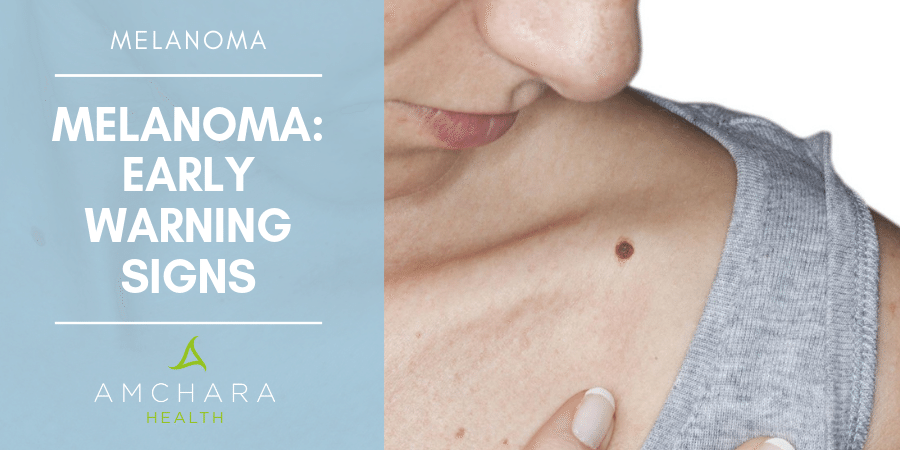Topics Covered in this article:
Most of us have moles on our skin, the vast majority of which are harmless.
However, some moles are capable of changing into skin cancer.
We always take an evidence-based approach and in this article we’ll discuss how to spot the early-warning signs of melanoma, one type of skin cancer.
What is Melanoma?
Melanoma is a cancer which begins in skin cells called melanocytes.
These sit in the lowest layer of the skin’s epidermis and produce melanin, the brown pigment which gives skin cells their natural colour.
Melanin is produced in response to sunlight and protects the skin against the damaging effects of ultraviolet rays by absorbing their radiation.
Moles develop when melanocytes grow in clusters rather than being spread evenly through the skin.
Normally a mole is evenly coloured, being brown, black or tan in colour and is under 6mm in diameter – around the size of the blunt end of a pencil.
The most important aspect to remember is moles don’t usually change over time.
Other skin cancers include basal and squamous cell carcinomas, which develop in epidermal cells closer to the skin’s surface.
What makes melanoma different to other skin cancers is it’s more likely to spread to other parts of the body.
Risk of Melanoma
According to Cancer Research UK, around 16,000 new melanoma cases are diagnosed in the UK each year, which represents 44 cases every day.
Incidence is increasing, having more than doubled since the early 1990s, and it’s projected to rise still further (1).
Types of Melanoma
-
Superficial Spreading Melanoma
This is the commonest type of melanoma, accounting for 70% of cases, according to the NHS (2).
They’re most common in people with pale or freckled skin.
This type of melanoma develops over several years on the outer skin layer and tends to grow outwards rather than downwards.
It may be raised from the surrounding skin and have irregular borders.
Moles may be coloured black or brown with pink edges.
They may develop from existing benign moles or as new moles.
-
Nodular Melanoma
This type of melanoma accounts for 15%-20% of cases and is more frequent in older people. It usually first appears as a bump or growth on the skin’s surface which quickly grows into the deeper layers of the skin and commonly bleeds or oozes.
Nodular melanoma is known as invasive melanoma, which means it has penetrated into the skin.
Diagnosis of Melanoma
Melanoma is usually diagnosed by means of a tissue biopsy, along with examination of the lymph nodes.
Stages of Melanoma
Stages of melanoma are based on the size and thickness of the tumour, as well as whether it has spread from its initial site.
The thicker the tumour, the more likely it is to spread.
If it’s confined to the top layer of the skin, it is usually removed by surgery.
This is the reason it’s crucial moles are spotted early on in their development.
If melanoma spreads it is known as metastatic melanoma. Commonly it travels to the lymph nodes, liver, bones, brain or lungs.
Symptoms depend on the location in the body the cancer has spread to, but may include fatigue, swollen lymph nodes and weight loss.
Early Indications of Melanoma
Because melanomas develop on the skin’s surface, there is a good chance they will be detected early on in their development.
That’s why it’s incredibly important to regularly examine your skin for any changes.
Experts recommend examining your skin head to toe every month.
Many melanomas develop on skin which is exposed to the sun, such as the chest, back or legs, but they may also appear on areas which don’t normally see the sun, such as between the toes, on the palms of the hands, soles of the feet and even the genitals.
They may also develop in the eyes where they’re known as ocular melanoma.
This accounts for around 3% of all melanoma cases.
Warning Signs
You should be looking for changes in existing moles with respect to their size, shape or colour, or any new spot or mole which develops on the skin.
Take a closer look if you become aware of the following:
- Sores which don’t heal
- Redness, pigment or swelling which extends beyond the border of a spot or mole to the skin around it
- Itchiness or tenderness
- Blurred vision, dark spots in the iris or partial loss of sight – these are signs of ocular melanoma
The ABCDE Diagnostic Method
When examining your skin for possible melanomas, think ABCDE.
A – Asymmetry. The mole may have an irregular shape with two different halves if you draw a line through it.
B – Border. The edge of the mole is irregular and notched rather than smooth.
C – Colour. The mole may be uneven in colour, being a mix of pigments – pink, red, white or even blue – or it may have dark spots. Amelanotic melanomas don’t have any pigment at all, so they are harder to spot.
D – Diameter. The mole may be larger than 6mm in diameter. Bear in mind some non-cancerous moles can be larger than this and some melanomas may be smaller, so size isn’t the only indication.
E – Evolving. The mole or spot may change size, shape or texture, or it may be elevated or raised when it was not before. It may start to itch, bleed, crust over or ooze fluid. Melanomas tend to change at a different rate to other moles on the body.
The Ugly Duckling Diagnostic Tool
Because melanomas sometimes don’t fit into the ABCDE model, recently the ‘ugly duckling sign’ has been suggested as a factor to look out for when examining your skin.
Basically this means looking out for any mole which is atypical, in other words different in size, shape or colour to any other mole you may have.
We are usually either born with moles or develop them in our childhood or as a young adult, so any new moles which appear in adulthood should be examined carefully.
Any moles we do have tend to have broadly similar characteristics, a little like siblings in a family.
For example, if a person has mainly large, dark-coloured moles and sees one which is reddish and smaller, it would be important to have this checked out.
Sometimes the difference can be non-specific: the mole simply feels different to the others.
If you see anything out of the ordinary, consult your GP as soon as possible.
Protecting Your Skin
-
Use a Natural Sunscreen
Sunlight has a myriad of health benefits.
It’s known to improve mood because it boosts feel-good chemicals known as endorphins (3) and induces quality sleep, especially if we obtain some sun exposure in the morning (4).
It also positively benefits the immune system by enabling us to manufacture vitamin D, which has a host of other functions including improving bone health and regulating mood (5).
Vitamin D deficiency is widespread in the UK, with an estimated 20% of us having low levels of this essential nutrient (6).
On the other hand, burning the skin is positively associated with the development of skin cancers.
One study on over 110,000 women found those who had suffered from sunburn five or more times between the ages of 15 and 20 were 80% more likely to develop melanoma (7).
It’s estimated in the UK that having 13 minutes of sun exposure to 35% of your skin close to midday on three days per week is sufficient to allow your body to manufacture adequate vitamin D levels (8).
This is only true for Caucasian skin, as darker skin will need longer in the sun to make the same amount of vitamin D.
So by all means expose your skin to the sun for short periods to obtain its positive health benefits, but if you’re going to be outside for longer than 30 minutes or if the sun is hot, it’s essential to use a sunscreen.
Those made with physical filters such as zinc oxide are the safest, as sunscreens with chemical filters such as oxybenzone have been linked to alterations in female hormone balance (9).
Avoid sunscreens containing nanoparticles of zinc, however, as currently it’s uncertain whether these particles can be absorbed into the bloodstream.
-
Antioxidant Power
When sunlight hits the skin, free radicals are formed, which can damage the skin over time.
Free radicals are molecules missing an electron and because of this, they’re unstable.
They need to steal an electron from elsewhere, and in doing so they have a tendency to set off a chain reaction of other unstable molecules.
They can damage cell membranes or even DNA in this way.
This is where antioxidants come in, as they possess an extra electron which can effectively stop this chain reaction in its path.
In order to counter the damaging effects of free radicals, it’s important to include plenty of antioxidants in your food.
They’re contained in fruit and vegetables where they give the foods their pigment.
Because antioxidants work in tandem with one another, it’s best to eat a wide variety of different coloured plant-based foods, to make sure you are consuming a good range of different antioxidants.
Conclusion
If you are concerned about your skin, it’s important to see your GP as soon as possible to enable early identification and treatment of melanoma before it can spread.
If you would like to support your skin health by nutritional and lifestyle choices, a consultation with an experienced Amchara practitioner can help.
We’re dedicated to providing you with both insightful information and evidence-based content, all orientated towards the Personalised Health approach.
We believe sharing knowledge and experience is an important part of achieving optimal health and would love to hear your views.
With your help let’s continue the conversation.
Did you find this article useful?
What are your strategies to support skin health?
Please share your thoughts in the comments.
READ THIS NEXT:




